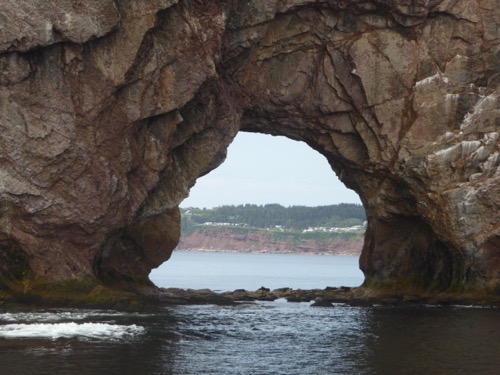We had such a long drive yesterday - NOT. Only 65 miles along the coast to Percé but the scenery was stunning and the town is quaint as well but definitely a tourist destination. Since it was a short drive I drove the Jeep and followed John. Several times I almost pulled over to just stare at the beauty of this coastline. Flat topped cliffs jutting out into the gulf with colorful cottages dotting its top; a small river emptying into the gulf created a sandy beach; and mountain tops covered with lush forests and rocky shelves. Truly beautiful.
Through the arch in the distance is our RV parked above the cliff.
For supper last night our wagon-master got each of us a 1-pound whole lobster! We brought our own shell crackers, they provided a bib, We brought wet wash clothes and they provided a pasta salad and then the fun began! Oh what a mess of goodness, laughter and full tummies!
Today we viewed a film about Bonaventure Island and its avian inhabitants then took a boat ride out and around the island before landing to go ashore. Janet, Mellow, John and I then took a winding trial through the forest, up and over to the far side of the island where the Gannet colony can be seen, heard and smelled.
This Gannet colony is the largest in North America and the second largest in the world. The Gannets are very social birds as evidenced by the exact 80 cm distance between each and every nest. Close enough to visit but far enough to claim as their own territory. The Gannet mates for life so when the male lands (which is not very gracefully) where he thinks his mate is located he runs the risk of being attacked by a strange female. To make sure the female is his, he bites the lady on the neck. If she doesn’t like it he knows to look elsewhere. When he finds his wife they do this fencing maneuver with their sharp beaks to show their “love”. Once they lay an egg (they only have one chick per year) both of them will take turns sitting on it until it hatches in 44 days. They they both care for the chick by feeding it regurgitated food in their gullet. Once the chick molts and has all it feathers it is pretty much set out on its own, even learning how to fly all by itself.
Many other birds nest on this island as well. Most we had never heard of like the Mure, a cousin of the South American penguin, herring gulls, black guillemots and black legged kikiwaites, a cousin of the gull. We also saw cormorants and harlequin ducks. Most of these were nesting on the side of the cliffs in each and every crevice and ledge you could see while seals swam below and pilot whales surfaces just off shore. It was an amazing day.







No comments:
Post a Comment